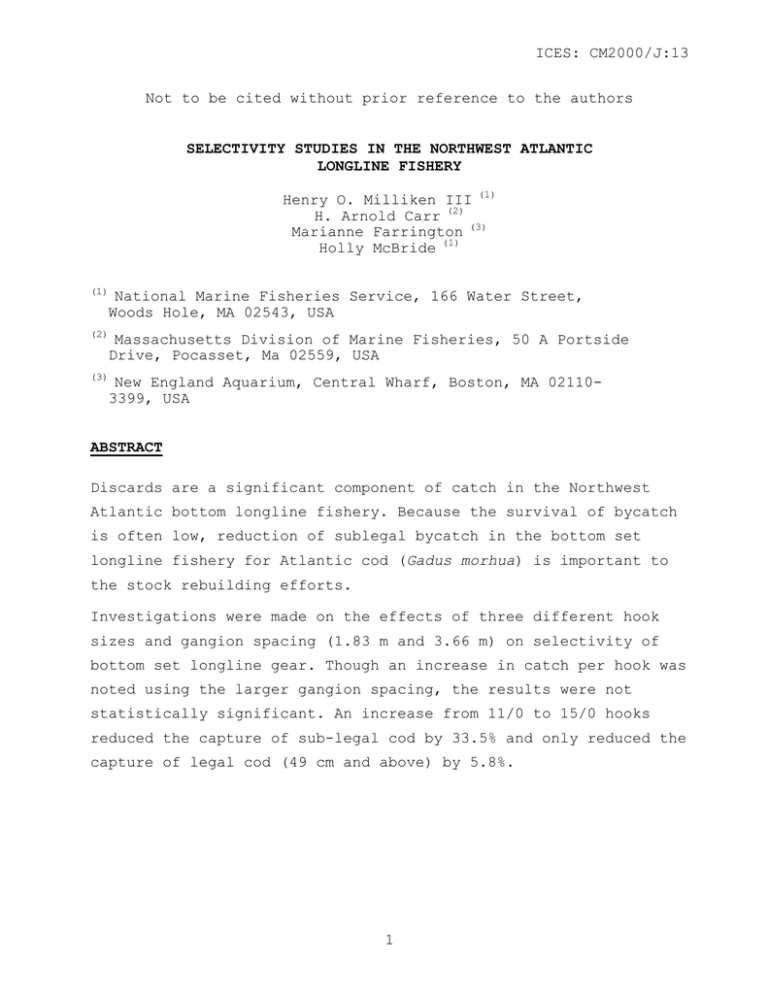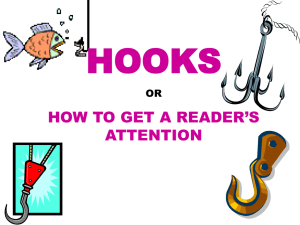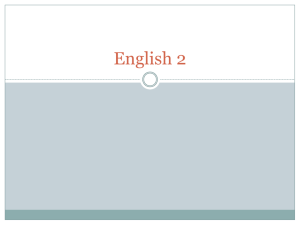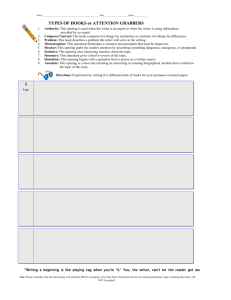ICES: CM2000/J:13 Henry O. Milliken III
advertisement

ICES: CM2000/J:13 Not to be cited without prior reference to the authors SELECTIVITY STUDIES IN THE NORTHWEST ATLANTIC LONGLINE FISHERY Henry O. Milliken III (1) H. Arnold Carr (2) Marianne Farrington (3) Holly McBride (1) (1) National Marine Fisheries Service, 166 Water Street, Woods Hole, MA 02543, USA (2) Massachusetts Division of Marine Fisheries, 50 A Portside Drive, Pocasset, Ma 02559, USA (3) New England Aquarium, Central Wharf, Boston, MA 021103399, USA ABSTRACT Discards are a significant component of catch in the Northwest Atlantic bottom longline fishery. Because the survival of bycatch is often low, reduction of sublegal bycatch in the bottom set longline fishery for Atlantic cod (Gadus morhua) is important to the stock rebuilding efforts. Investigations were made on the effects of three different hook sizes and gangion spacing (1.83 m and 3.66 m) on selectivity of bottom set longline gear. Though an increase in catch per hook was noted using the larger gangion spacing, the results were not statistically significant. An increase from 11/0 to 15/0 hooks reduced the capture of sub-legal cod by 33.5% and only reduced the capture of legal cod (49 cm and above) by 5.8%. 1 ICES: CM2000/J:13 INTRODUCTION Longline gear has been described as highly selective for both species and size compared to trawl gear (Bjordal, 1988; Lokkeborg and Bjordal, 1992; Nedreaas et al., 1993; Neilson et al., 1989). Nevertheless, longlines catch sublegal fish; and the bycatch mortality of sublegal cod can be quite high (Milliken et al., 1999). In order to reduce the catch and associated mortality of sublegal cod, researchers have investigated the effects of hook size, hook shape, the spacing between adjacent hooks, bait size, bait type, depth of set, habitat, the size distribution and densities of fish on the grounds (Lokkeborg and Bjordal, 1992; Bjordal, 1988). It is generally thought that an increase in the number of hooks results in an increased catch per unit of effort (CPUE)(Beverton and Holt, 1957; Gulland, 1969). Experiments on modifying the space between hooks have shown an increase in the catch per hook with an increase in the spacing between hooks (Hamley and Skud, 1978). These results can be attributed to the effects of saturation (Murphy, 1960; Ionas, 1966; Lokkeborg and Bjordal, 1992). When only a certain number of fish are present, they are all susceptible to the gear. When more hooks are present, they may catch more fish but the catch per hook might be reduced because there are fewer fish available to the gear. Results of studies of the effects of hook size on selectivity are inconsistent. An increase in hook size does not necessarily reduce the catch of smaller fish. For example, Orsi et al. (1993) found no significant difference in the catch of sublegal (<66 cm) Chinook salmon (Oncorhyncus tshawytscha) when he compared a small and large hook size, yet Otway and Craig (1993) in a study of snapper (Pagrus auratus) found that a larger hook reduced the 2 ICES: CM2000/J:13 catch of the smaller individuals, although a smaller hook increased the capture of larger individuals. Some of the inconsistent results of hook size selectivity studies may arise from the confounding effects of hook size, bait size and bait type (Lokkeborg and Bjordal, 1992, Otway and Craig, 1993). Johanessen (1983, cited by Lokkeborg, 1990) evaluated selectivity due to bait size separately from that due to hook size, and concluded that bait size had a larger effect on selectivity than hook size. Increased spacing between hooks may increase the average size of fish in the catch. Studies on the behavior of cod in the vicinity of baited hooks show that larger fish are better at competing for baited hooks, and actively frighten smaller fish away (Bertran, 1988, Lokkeborg and Bjordal, 1992; Engas et al., 1993). METHODS Gangion Spacing: Two commercial vessels were provided with three sets of 250 hooks of 11/0 circle hooks spaced 1.83 m (6 ft.) apart and three sets of 175 hooks of 11/0 circle hooks spaced 3.66 m (12 ft.) apart. All gangion lengths were 40.6 cm (16 in.) The fishing occurred in areas that the commercial fishermen had gear and nineteen sets of each gear were fished and recorded. Trained fisheries biologists were aboard each vessel and recorded all the catch data. Because the data were not paired for the different hook spacings used, a t-test that assumed unequal variances was used to test for differences in catches between the size of cod caught between the two spacings after the data were standardized to catch per hook. 11/0 vs. 13/0 selectivity: Two commercial boats were each given four sets of 250 11/0 Mustad circle hooks and four sets of 250 13/0 Mustad circle hooks (Figure 3 ICES: CM2000/J:13 1). The hooks were spaced 1.83 m (6 ft.) apart and baited with a similar bait type and size. All gangion lengths were 40.6 cm (16 in.) The sets were fished like commercial gear with each string containing alternate sets of hook size to minimize the effects of bottom differences. hauls. Trained fisheries biologists observed all Measurements were taken for all cod and haddock and recorded with the appropriate hook size. Because the data were not paired for the different hook sizes used, a t-test was used to test for differences in catch rates between the two hook sizes. The data were transformed to catch per hook for the analysis. 11/0 vs. 15/0 selectivity: One commercial vessel fished commercial longline gear. Each haul consisted of three lines with 300 hooks, spaced 1.83 m (6 ft.) apart; accordingly 900 hooks were fished per haul. The gangions were 40.6 cm (16 in.) long and the lines were rigged with alternating hook sizes. Therefore, each haul had 450 hooks of 11/0 and 450 modified 15/0 hooks alternately spaced. The 15/0 hooks were constructed from the same gauge wire that was used to construct the 11/0 hooks (Figure 1). Hooks were baited with squid and clams and the sizes of the bait were kept constant for both hook sizes. The vessel fished for twelve days and usually fished four hauls a day, though six hauls and three hauls in a day also occurred. A paired t-test was used to evaluate the effect of hook size on the catch of legal (49 cm and above) and sub-legal (below 49 cm) cod. The data were separated into legal and sub-legal catch for each haul. A paired t-test was performed on the catch rates between the two hook sizes to determine if the different hook sizes selected for different sized fish. 4 ICES: CM2000/J:13 RESULTS Gangion Spacing No significant differences (α < 0.05) were detected in the catches per 250 hooks between 34 sets with the gangions spaced 1.83 m (6 ft.) apart and 35 sets with the gangions spaced 3.66 m (12 ft.) apart (Table 1). The 3.66 m spacing resulted in a 26.6% increase in the total catch of cod caught per hook, a 31.6% increase in the catch of sub-legal cod caught per hook and a 22.6% increase in the catch of legal cod caught per hook relative to the 1.83 m spacing (Table 1). A Kolmogorov-Smirnov test on the length frequencies of the two spacings detected no difference between the treatments (Figure 2, Table 4). 11/0 vs. 13/0 There were no significant difference (α < 0.05) in the catch rates by 11/0 and 13/0 hooks (Figure 3, Table 2). Use of the 13/0 hooks resulted in an 11.1% reduction in the total catch of cod, a 23.9% reduction in the catch of sub-legal cod and a 2.6 % reduction in the catch of legal cod (Table 2). A Kolmogorov-Smirnov test on the length frequencies of the two spacings detected no difference between the treatments (Figure 4, Table 4). 11/0 vs. 15/0 There was a significant difference (α < 0.05) in catches of all cod and catches of sublegal cod by 11/0 and 15/0 hooks. There was no significant difference in the catch of legal cod (Figure 5, Table 3). Comparisons of the catch rates of 52 sets of the two hook sizes showed that the 15/0 circle hooks resulted in a reduction in the total catch of cod by 14.6%, a 33.5% reduction in the catch of sub-legal cod and a 5.8% reduction in the catch of legal cod (Table 3). A Kolmogorov-Smirnov test on the length frequencies of the two spacings detected a highly significant difference (α < 0.01) between the treatments (Figure 6, Table 4). 5 ICES: CM2000/J:13 DISCUSSION Catch per hook of all the cod increased when the larger 3.66 m gangion spacing with 125 hooks was compared to the 1.83 m spacing with 250 hooks. It is difficult to state conclusively if the higher cod catch per hook rates when using the 3.66 m spacing was the result of differences in the populations of cod available to the gear or more likely, due to the fact that the larger spacing caught more cod per hook because more cod were susceptible to capture by each hook due to the fewer number of hooks present. It is probable that the gear with the larger spacing was closer to saturation than when the hooks were spaced closer together. This would result in higher catches per hook. Similar findings were reported by Hamley and Skud (1978) in a study of hook spacing in the halibut fishery. They theorize that as hook spacing increases, catch per hook also increases in an asymptotic function. Though the 13/0 hook did not show a statistically significant difference in the catch of sub-legal cod relative to the 15/0 hooks, the 24% observed difference bears further investigation. Few cod were caught by either hook size during the sampling period. The 15/0 hook did show a reduction in the catch of all cod and sub-legal cod caught. Additionally, the paired t-test did not detect any differences in the catch of legal cod caught between the two hook types. The effect of additional increases of hook size (11/0 vs. 15/0) in fact reveals a significant effect of hook size on catch of sublegal cod. This reduction is substantial yet lends itself to the question: can we reduce the catch of sublegal cod further? The logical progression of this work would be to increase the hook size again to determine if we can reduce the catch of sublegal cod further. 6 ICES: CM2000/J:13 TABLES T-test: Assuming Unequal Variances Distance between gangions Total catch per 1000 hooks / set Mean per 250 hooks Variance Observations Hypothesized Difference Df t Stat P(T<=t) two-tail t Critical two-tail All Cod 1.83 m 113.9 28.618 487.031 34 0 65 -1.264 0.211 1.997 3.66 m 144.2 36.057 710.703 35 Sub-legal Sized Cod (<49 cm) 1.83 m 3.66 m 43.1 56.7 10.765 14.171 70.670 114.440 34 35 0 64 -1.473 0.146 1.998 Legal Sized Cod (>49 cm) 1.83 m 3.66 m 70.8 87.5 17.853 21.886 317.584 423.281 34 35 0 66 -0.871 0.387 1.997 Table 1: Results of t-test analysis on the standardized catch data for the three grouping in the hook spacing experiment. T-Test: Assuming Unequal Variances Size of circle hook used Total catch per 1000 hooks / set Mean per set (250 hooks) Variance Observations Hypothesized Difference Df t Stat P(T<=t) two-tail t Critical two-tail All Cod 11/0 88.67 22.167 421.797 24 0 35 0.379 0.707 2.030 13/0 78.82 19.706 418.596 17 Sub-legal Sized Cod (<49 cm) 11/0 13/0 32.17 24.47 8.333 6.235 87.601 46.316 24 17 0 39 0.831 0.411 2.022 Legal Sized Cod (>49 cm) 11/0 13/0 55.33 53.88 13.83333 13.471 138.2101 195.140 24 17 0 31 0.087 0.931 2.039 Table 2: Results of t-Test analysis on the standardized catch data for the three grouping in the hook size experiment. Paired t-Test Size of circle hook used Total catch Mean per set Variance Observations Pearson Correlation Hypothesized Difference Df t Stat P(T<=t) two-tail t Critical two-tail All Cod 11/0 1715 33.019 670.921 52 0.869 0 51 2.680 0.010 2.008 15/0 1464 28.250 466.309 52 Sub-legal Sized Cod (<49 cm) 11/0 15/0 547 364 10.519 7.000 158.843 66.471 52 52 0.920 0 51 4.215 0.000 2.008 Legal Sized Cod (>49 cm) 11/0 15/0 1168 1100 22.500 21.250 394.647 369.211 52 52 0.868 0 51 0.895 0.375 2.008 Table 3: Results of a paired t-test analysis on the standardized catch rate for the three groupings in the hook size experiment. 7 ICES: CM2000/J:13 Kolmogorov-Smirnov Test Results Hook Spacing Experiment Significant D.01 Difference? Comparison D D.05 __________________________________________________________ 1.83 vs. 3.66 2.8031 3.8068 4.5623 NO ************************************************************* Hook Size Comparison Experiments Comparison D D.05 D.01 Significant Difference? __________________________________________________________ 11/0 vs. 13/0 0.0924 0.4121 0.4939 NO 11/0 vs. 15/0 0.0867 0.0553 0.0663 YES** __________________________________________________________ ** Significant difference at α = 0.01. Table 4: Results of Kolmogorov-Smirnov test on the length frequencies of cod caught t determine if both hook sizes selected for the same sized fish. 8 ICES: CM2000/J:13 FIGURES Figure 1. Hook sizes used in selectivity experiments. Cathc per 1000 Hooks 12 10 1.83 m Legal Size 48.3 cm (19 in.) 8 3.66 m 6 4 2 0 0 10 20 30 40 50 60 70 80 90 100 Length (cm) Figure 2. Number of Cod Caught per 1000 Hooks on 1.83 m (6 ft) Spaced Strings and 3.66 m (12 ft) Spaced Strings. Length frequency comparison standardized to catch per hook for cod caught in both treatments. 9 ICES: CM2000/J:13 Figure 3. Means and 95% confidence intervals for all, sublegal and legal sized catches of cod from the 11/0 and 13/0 hooks. The data were grouped by haul. Catch Per String (250 hooks) 11/0 vs. 13/0 Circle Hooks 2 Number Caught per String 1.8 11/0 Legal Size 48.3 cm (19 in.) 1.6 1.4 13/0 1.2 1 0.8 0.6 0.4 0.2 0 0 10 20 30 40 50 60 70 80 90 100 110 Length (cm) Figure 4. Length frequencies for both 11/0 and 13/0 hooks standardized to number caught per 250 hooks. 10 ICES: CM2000/J:13 Figure 5. Means and 95% confidence intervals for all, sublegal and legal sized catches of cod from the 11/0 and modified 15/0 hooks. The data were grouped by haul. Total Number Caught 70 Legal Size 48.3 cm (19 in.) 60 11/0 50 15/0 40 30 20 10 0 0 10 20 30 40 50 60 70 80 90 100 110 Length (cm) Figure 6. Hook Catchability Comparison 11/0 vs. 15/0 Circle Hooks. Because an equal number of hooks were fished, the data were not transformed. 11 ICES: CM2000/J:13 REFERENCES Bertrand, J. 1988. Selectivity of hooks in the handline fishery of the Saya de Malha banks (Indian Ocean). Fish. Res. 6: 249-255. Beverton, R.J.H and S.J. Holt. 1957. On the dynamics of exploited fish populations. U.K. Ministry of Agriculture, Fisheries and Food, Fishery Investigations, Series II, Volume XIX, 533 p. Bjordal, A and S. Lokkeborg. 1996. Longlining. Fishing News Books. The University Press, Cambridge, 1996. Bjordal, A. 1988. Recent developments in longline fishing – catching performance and conservation aspects. IN: Proceedings of the World Symposium on Fishing Gear and Fishing Vessel Design, St. John's Newfoundland. Canada. November 21-24, 1988. Newfoundland Labrador Institute of Fisheries and Marine Technology. St. John's Newfoundland. Engas, A., S. Lokkeborg, A.V. Soldal, E. Ona. 1993. Comparative fishing for cod and haddock with commercial trawl and longline at two different stock levels. NAFO Scientific Council Meeting on Gear Selectivity and Technical Interactions Symposium. September 1993, Dartmouth, Nova Scotia Canada. NAFO SCR Doc. 93/117. Gulland, J.A. 1969. Manual of methods for fish stock assessment. Part 1. Fish population analysis. Food and Agriculture Organization of the United Nations, FAO Manuals in Fisheries Science, No. 4, 154 p. Hamley, J.M. and Skud, B.E. 1978. Factors affecting longline catch and effort: II. Hook spacing. Int. Pac. Halib. Comm. Sci. Rep. 64: 15-24 Johanessen, T. 1983. Influence of hook and bait size in catch efficiency and length selection in longlining for cod (Gadus morhua L.) and haddock (Melanogrammus aeglefinus L.). Bergen, Norway. University of Bergen. Cand Real. thesis. 109p. (In Norwegian - not read in original but information cited in Lokkeborg 1990). Lokkeborg, S., and A. Bjordal. 1992. Species and size selectivity in longline fishing: a review. Fish. Res. 13: 311-322. 12 ICES: CM2000/J:13 Milliken, H.O., M. Farrington, H.A. Carr, and E. Lent, 1999. Survival of Atlantic Cod (Gadus morhua) in the Northwest Atlantic Longline Fishery. Mar. Technol. Soc. J., vol. 33, no. 2, pp. 19-24, 1999. Nedreaas, K., A.V. Soldal and A. Bjordal. 1993. Performance and biological implications of a multi-gear fishery for Greenland halibut (Reinhardius hippoglossoides). NAFO Scientific Council Meeting on Gear Selectivity and Technical Interactions Symposium. September 1993, Dartmouth, Nova Scotia Canada. NAFO SCR Doc. 93/118. Neilson, J.D., K.G. Waiwood, and S.J. Smith. 1989. Survival of Atlantic halibut (Hippoglossus hippoglossus) caught by longline and otter trawl gear. Can. J. Fish. Aquat. Sci. 46: 887-897. Orsi, J.A., A.C. Wertheimer, H.W. Jaenicke. 1993. Influence of selected hook and lure types on catch, size, and mortality of commercially troll-caught salmon. North Am. J. Fish. Manage. 13: 709-722. Otway, N.M and J.R. Craig. 1993. Effects of hook size on the catches of undersized snapper Pagrus auratus. Mar. Ecol. Prog. Ser. 93: 9-15. AKNOWLEDGEMENTS Funding for these studies was provided by National Marine Fisheries S-K grants. Many thanks to Jessica Harris who entered the data for the spacing and 11/0 and 13/0 hook studies. Furthermore we would like to thank the captains and crews of the F/V Susan Lee, F/V Sea Bag, F/V Sea Win, and the F/V Sea Holly. 13






